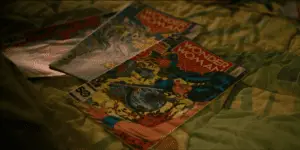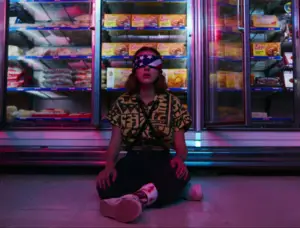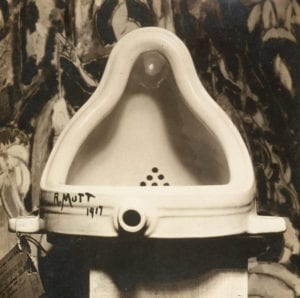Content warning: article contains discussion of child abuse; Spoiler warning for all three seasons of Stranger Things
As I mentioned in my previous article, El’s character arc weaves together a girl’s empowerment with her social connections to other women and with recovering from child abuse. We see this prominently in “Chapter Two: The Mall Rats” as she bonds with Max, learning about herself and her independence. Their bond deepens even more in the following episode, “Chapter Three: The Case of the Missing Lifeguard”, as they search for a missing teen-aged girl, and have a sleepover. The Duffer brothers’ enrich each scene with eye-popping color palettes and pop cultural references to invoke hyper-American, hyper-80s nostalgia. While Max and El do not have their own adventures separate from the boys for the rest of the season, the visuals throughout the entire season work together on this front.
These images communicate certain themes and narratives that deepen the story and characters. Thematic and cinematic parallels that surround El reveal an arc of womanly reclamation, one based in the interplay between humanness, compassion, and divinity. By learning to balance the legacy of her mother and life with Brenner, El becomes a more-rounded person and hero. She learns to heal and to fight for others.
Specifically, the imagery surrounding El reminded me of ‘Fountain’, a highly-influential and controversial piece from modern art, and of Sansa Stark from the A Song of Ice and Fire book series (ASoIAF) by George R. R. Martin. These connections work in tandem with the Wonder Woman reference we see in “Chapter Four: The Sauna Test”, before they reunite with the boys. The connections enrich El’s arc as a girl discovering her identity separate from men. This identity is rooted in her relationships with other women, especially in opposition to patriarchal oppression.

Wonder Woman: rejecting the father
As another aspect of her feminist mentorship, Max introduces El to Wonder Woman. At the beginning of the episode, they read Issue #326 (which came out early July 1985, matching season three’s timeline). It follows Wonder Woman as she travels to the fictional Central American country of Tropidor in order to locate two missing colleagues. The comic follows several characters during political unrest, including reporters and government agents, yet Wonder Woman acts as an agent for ideals. During one fight scene, she declares herself “a citizen of the world”, rejecting a guerilla soldier’s claim that she’s only an American pawn for dissent. She also asserts that her universal respect lies in her womanhood i.e. in her feminine-coded values of love and compassion, which had also been instilled by her mother and by the Amazons. In this respect, Wonder Woman rails against kyriarchal systems of borders and (toxic) nationalism.
This tension in gender, feminism, and violence is further explored in Patty Jenkins’s Wonder Woman. (I will refer to it as WW17 and to this incarnation of Wonder Woman as Diana.). Diana and El came from mirrored worlds of isolation — Hawkins, and Man’s world in general, are any Themysciran’s Upside Down — and their stories deal with innocence. Diana lives in Paradise, and she loses her innocence once faced with the horrors of Man’s world. Towards WW17’s climax, she considers quitting because “[mortals] do not deserve [help.]” But Diana, Princess of Themyscira, can’t be downtrodden too long, and she reembraces her fighting spirit. She fights not out of any external reward or expectation of the target’s goodness; she fights from personal conviction, for the inherent value of ideals instead of just the end result. Before he sacrifices himself, Steve tells her, “I can save today. You can save the world.” Similarly, as El is leaving her, Kali exclaims, “They can’t save you, Jane.” El only responds, “No. But I can save them.”
In her article on gender and No Man’s Land, Sarah explains that Diana was, “[c]harging into the masculine realm from a female space […] [because she] engages in violence, allows for death and destruction—from a feminine place of love and protection.” The term “no man’s land” itself develops on this decades-old declaration of being “a citizen of the world” as it is a liminal space between factions. Sarah’s analysis of WW17 summarizes El’s character arc as she goes from reactive self-defense, such as killing the government agents who hunted her in season one, to the proactive defense of those less empowered than her. Such an arc also tracks as an arc of feminist awakening. As a girl matures into a woman, she accumulates skills and knowledge that empower her to rage against guilt and to fight back for her sisters, and this has become more relevant in today’s understanding of intersectional feminism. With that comes using privilege as a shield for the more marginalized, rather than using privilege as a shield against criticism and consequences.
Furthermore, WW17 Diana shares similarities with El in terms of subverting objectification for the purpose of war and its relationship with patriarchal, quasi-religious dominance. Abusive relationships and their tactics mirror systemic, institutional forms of oppression. This relationship between perpetrator and target also darkly parallel the connection between a god and a believer. Now, before the Internet crucifies me, let me explain. (It should be said that there is nothing wrong with faith, practicing an organized religion, or going to a place of worship.) In an abusive relationship, the perpetrator isolates the target and hijacks their thoughts, slowly poisoning them in order to wear down their self-worth and independence. Abusive tactics like isolation and shaming are used by violent partners and by manipulative groups like cults. The isolation and shame raise the perpetrator to godlike stature. Perpetrators deify themselves and then expect their targets to join in on their worship.
This dynamic is best summarized in Sierra DeMulder’s poem ‘After Googling Affirmations for Abuse Survivors’: Do you know how hard it is/to write yourself draped only in softness, to not worship/the shipwreck that stranded you here? When someone you care about power over you and uses that power to hurt you, it’s natural to almost perversely worship them, especially when they have you so isolated and disempowered that to incite their wrath could be life or death. In El’s case, she experienced both sides because “Papa” had been all she had ever known. She wanted to please him; she also wanted to not be hurt anymore and to live a normal life.
Religion and militarism are deeply intertwined. Historically, religion has been used as justification for war, colonization, and the subjugation of marginalized classes. Both heroines have their origins in war (though in El’s case, a cold war). In WW17, Ares reveals that Zeus fathered Diana to be left as a “weapon” against him, known among her people as the “Godkiller.” Unknowingly pregnant, Terry Ives participated in drug-fueled government experiments, and thus El was born with powers that Brenner sought to exploit. Men in power created “daughters” to be used as weapons, positioning Diana and El towards a specific destiny much like a prophecy of divine origin. They were meant to be tools for a greater power, but they rebelled and “fell” from godhood. In Diana’s case, she left Themyscira to help mortals and though she destroyed Ares as intended, she did not do it for Zeus but for humanity. El had escaped from Hawkins Lab, renounced Brenner as her father figure, and began a normal life. After the Mindflayer infected her, she then lost her powers, and season four will likely explore how she gets them back. Such a “fall” complicates her character as she navigates a less physical space of empowerment. She lost both of her fathers and must confront that.

Fountain: a mother’s legacy
One of El’s central tensions lies in maternal loss versus paternal abuse — which she finds some resolution in her loving adoptive father. This tension is rooted in men exploiting power-based systems. After reviewing the second connection, I understood this tension better.
In “Chapter Seven: The Bite”, El and the other kids have taken shelter in a convenience store, and the cinematography is rich in colored lighting and product placement. In a meme-able moment, she uses her ESP to track down Dustin, sitting cross-legged and wearing an American flag as a blindfold. With the show’s signature Eggos backlit, they form a humorous golden halo around El, whose pose reinforces the beatific imagery. The shot immediately reminded me of ‘Fountain’, one of the most notorious pieces in modern art history. While the Duffer brothers likely did not intend this connection, the urinal’s true backstory resonates thematically with El’s origin in abduction and appropriation.

At the time of its creation, ‘Fountain’ was submitted in early April 1917 to New York’s Society of Independent Artists for its open exhibit. The Society advertised that it would display every submitted piece, should the entry fee be paid, but they rejected the urinal. Doing this, they were forced to acknowledge a definition of art. Alfred Stieglitz, photographer and husband of Georgia O’Keefe, then photographed ‘Fountain’ before it disappeared — likely having been accidentally thrown out. In the 1930s, an art critic attributed ‘Fountain’ to French painter Marcel Duchamp, who is now considered a father of the Dada art movement. Duchamp went on to claim ‘Fountain’ in the mid-50s and produced commissioned replicas for museums. In its review of Duchamp’s revised biography, the Scottish Review of Books describes the historical moment as, “The submission and rejection of Duchamp’s urinal is now regarded as one of the key, early turning points in the history of modern art[.]”
Though not acknowledged by the greater world of art history, several Dada and Duchamp scholars now agree that Duchamp stole ‘Fountain’ from a female artist and poet named Elsa von Freytag-Loringhoven (VFL).
German-born and titled from her third marriage, Baroness Elsa von Freytag-Loringhoven lived art in motion. Her performance never stopped — such as wearing found objects like tin cans for bras — transgressing bodily and artistic norms, with the body as canvas and gallery. Her life story and her urinal parallel the story of Terry and El as a story of the appropriation of womanhood and fighting against masculine authorities. Initially forgotten and seen as only that womanly kind of crazy, VFL has since been revived by the works of writers like Irene Gammel, whose biography Baroness Elsa contextualized the artist in her entirety. To understand VFL, as Gammel demonstrates, requires looking beyond her eccentricities and asking why. It recalls Terry’s sister Becky not believing her, seeing her only as conspiratorial and paranoid for no apparent reason, chalking up her belief in El’s existence to maternal grief.
Indeed, echoing El’s abuse and mistreatment, VFL endured childhood abuse from a cruel father and watched him abuse her mother, Ida. As El comes from a feminine place of love, using masculine-code violence to combat against patriarchal forces, so did VFL experiment with androgyny and the masculine, while pulling inspiration from her mother for art. For example, in her late teens, VFL watched as her mother began to fight back through the feminine archetype of the mad religious woman. Gammel writes that:
There was an unusual fierceness to Elsa’s personality, suggesting that her reaction against childhood trauma caused by family disharmony and violence is at the core of her psyche. […] Elsa commandeered her father’s symbols of power, most notably, his fondness for the bawdy and scatological. […] Aggressive jokes, then, present an opportunity to reclaim control and power, all the more transgressive for girls, as they involve a rejection of feminine docility. […] Theatrical, spectacular, and shocking, Ida’s “acting out” produced indelible memory pictures, ultimately imparting to [Elsa] the important legacy of maternal power that kept the patriarch at bay. (33-34, 40)
El’s coming-of-age, which includes empowerment from “Papa”, mirrors VFL’s discovering strength in gender except in the opposite direction. Her and Terry’s fight against Brenner also dovetails with Ida and VFL’s struggle against her father.
Because of Brenner’s abuse and assault on her body, he trapped Terry in her mind. She is forced to relive some of the worst “memory pictures” in her life, repeating a mantra of images and words. Her mantra includes “sunflower” and “rainbow”, both feminine symbols related to life and light. Through ESP, El experiences these memory pictures too, and they help her find Kali, her sister from the “rainbow room.” She rebuilds her own history. As I mentioned in my previous article, El’s philosophy regarding love and violence are formed by her mother and sister. That love comes from a very angry, protective place of feminine rage.
It relates to how El differs from Diana and is more like VFL: she uses masculine-coded tools of violence inherited from a paternal authority, but she fights for a lost mother. Diana chose to leave Themyscira and to leave her mother, while El was kidnapped and her mother immobilized.
With all that in mind, VLF created a pair of sculptures from plumbing to attack and to mock patriarchal authority figures. To contextualize ‘Fountain’, I will quickly go over one of VFL’s few, verified pieces known as ‘God.’ The Scottish Review described the 1917 piece as “a U-bend plumbing trap turned upside down and mounted on a carpenter’s mitre block (therefore framing it, by punning implication, in religion). It looked like a metal ‘g’ and Elsa called it God.” Notably, VFL’s father had been a mason and an atheist. He even had the title of ‘Maurermeister’, ‘master mason’ in German, implying his authoritative position over his family. Early in her childhood, he had compared bathroom routines to religious routines (Gammel pg. 29).
Mocking the omnipresence and omnipotence of the patriarchal deity, doing so using the tools of her father, VFL railed against the abusive jealousy, surveillance, and bodily control imposed by him and other masculine-dominated authorities. In regards to Stranger Things, El fights against Brenner and men like him with the powers they caused, and she becomes the surveillant through her ESP, able to surveille on her own terms, rather than at Brenner’s manipulations. Indeed, she uses an American flag as a blindfold to help with her surveilling. Brenner was a government agent and so she goes further in using her “father’s” tools against those who would hurt her.
And so that is the personal and aesthetic swirling around VFL leading up to the creation of ‘Fountain’.
The piece itself can be traced to the second (and final) volume of The Blind Man, the first Dada publication in the States. The photograph of ‘Fountain’, the source for all scholarship and reproductions, appeared in that issue and came with reviews and essays from fellow Dadaists. Artist Louise Norton titled her piece “Buddha of the bathroom” in reference to an anonymous quote about the sculpture’s appearance (p. 5). Its shape implies a beatific figure sitting cross-legged like El, stressed by the silhouette made in the lighting. Stieglitz mentioned that the Buddha resemblance was intentional, and he eventually rechristened the piece “Madonna of the Bathroom” (Gammel p. 224).
In his exhibition ‘A Lady’s Not A Gent’s,’ curator Glyn Thompson explained that VFL likely created ‘Fountain’ as a reaction to the U.S. going to war against Germany (timestamp 9:34-10:19). Thus ‘Fountain’ was one woman’s protest against violence and its relationship to masculinity/masculine space. It took the form of her choosing a receptacle from a men’s bathroom — a masculine space of bodily vulnerability. Her protest recalled her mother’s death and her father’s abuse, brought into large relief with her motherland under attack. She confronts God, the highest symbol of a systemic, authoritative patriarch, while simultaneously illuminating the beauty of a divine matriarchal figure.
By looking at VFL’s life story and her work, we can better see the themes of motherhood and appropriation in El’s storyline, especially in season three as she comes into her own.
Madonna in the Mall: survivor to survivor
Now, with all of that in mind, we have arrived at the third media connection. In the “Chapter Seven”, which had the saintly-Eggos image, her leg injury physically weakened her and made her rely on her friends for help. It subverts the twisted ankle trope seen in damsel characters because El received the injury in combat. There’s further subversion because Mike is the love interest tending to her wounds, rather than the other way around. The season finale, “Chapter Eight: The Battle of Starcourt,” expands on her disempowerment due to her power-loss. When a possessed Billy attacks El and intends to give her up to the Mindflayer, she is at her most physically vulnerable this season, arguably ever.
In previous seasons, when her powers drained her to the point of near-collapse, she could still fight off enemies if pushed to it. In this moment with Billy, him kneeling over her and physically overwhelming, she has nowhere to go. Earlier she had looked into his mind and seen his memories of a loving mother and an abusive father. El gasps out, “Seven feet,” in reference to that memory of his mother. She begins to describe, teary-eyed, the scene; she appeals to Billy’s humanity and acknowledges his long-lasting pain. She touches his face, and moved by her empathy, he saves her by sacrificing himself.
 The hand-on-the-face caught my eye on first viewing. It recalls Sansa Stark’s experience during the Battle of the Blackwater (BotB) in A Clash of Kings. She has an emotionally-charged encounter with Sandor Clegane. Sandor is triggered by the green wildfire during the battle and in a drunken stupor heads to her bedroom, hoping to convince her to leave with him. Misunderstandings ensue and he holds a knife to her throat, her completely vulnerable on the bed, and he demands the song ‘Florian and Jonquil’. She instead sings ‘The Mother’s Hymn’, whose lyrics call to “save our sons from war” and to “teach us all a kinder way” (p. 867). When Sansa cups his cheek, she feels his tears, and Sandor leaves in shame.
The hand-on-the-face caught my eye on first viewing. It recalls Sansa Stark’s experience during the Battle of the Blackwater (BotB) in A Clash of Kings. She has an emotionally-charged encounter with Sandor Clegane. Sandor is triggered by the green wildfire during the battle and in a drunken stupor heads to her bedroom, hoping to convince her to leave with him. Misunderstandings ensue and he holds a knife to her throat, her completely vulnerable on the bed, and he demands the song ‘Florian and Jonquil’. She instead sings ‘The Mother’s Hymn’, whose lyrics call to “save our sons from war” and to “teach us all a kinder way” (p. 867). When Sansa cups his cheek, she feels his tears, and Sandor leaves in shame.
Starting out as middle-school-aged, Sansa and El are protagonists in coming-of-age stories that focus on developing independence, fostering love and romance, and a girl’s budding sexuality. Sansa was also imprisoned and abused for an extended period of time because of her ‘usefulness’, specifically her claim to Winterfell. She also has latent psionic abilities rooted in warging, a gift that all the Stark children inherited. After losing her direwolf, her warging was stunted before it could truly develop. Sansa was stripped of everything except for her empathy and training in courtesy, both feminine-coded skills associated with her mother and with the Great Mother goddess. Indeed, the Great Mother that Sansa prays to and sings to comes from her mother’s religion.
Her reaching out to Sandor through the hymn, another survivor of childhood abuse, reflects the power in vulnerability and in mercy. The hymn condemns war, and through his character, the text condemns toxic masculinity. Sansa is embodiment of benevolent sexism in that being seen as a “lady” trapped her on a pedestal, so she subverts that by using her perceived meekness and weakness to survive. As she was stripped of her support, so was El stripped of power, but there’s a distinction in the origin of the empathy that saves them. El’s empathy was not nurtured by Brenner, and it was something she developed by forming connections outside of him, reinforced by discovering her mother’s love. She never knew benevolent sexism as she was forbidden from experiencing girlhood in any sense.
The Duffer brothers also explored these gender-assigned expressions of emotion, albeit differently. Abused by his father, season two introduces a Billy grown into a hypermasculine antagonist who abused Max and with his greased-up hair fit every murderous 80s-movie villain. Yet his father belittles him for caring about his appearance, reflecting the feminine-coded value in fashion and self-expression. This detail turns poignant when El zeroes in on his mother’s appearance, and the audience learns that a part Billy which his father hated was his mother. Even after she abandoned Billy to escape abuse, his father found a way to attack her and to tarnish Billy’s memory of her. In a sense, El knows him better than anyone else because she knows about the wounds and motives closest to his heart. Though there is no direct reference to Terry, it exists subtextually as El connects to Billy through his mother. His loss is something she feels acutely since she never had a mother to lose, having been stolen as an infant. She just knew an abusive “Papa.” Pointedly, after El sees the memories of abuse and goes to chase after a young Billy, she glares at his father.
While VFL’s story includes maternal loss and the appropriation of divinity, Sansa’s explores loss and then reclamation of feminine power. Wonder Woman in every incarnation, on the other hand, captures the strength of a maternal legacy, without needing to reclaim it. Thematically the stories speak to how El balances gender expression and values in contrast to the authority figures in her life. This includes Hopper who fails at communication and struggles with his daughter growing up. As I mentioned in part one, the heroine’s journey focuses on rediscovering the divine feminine. El does this by reclaiming the lost matriarch, a divine figure from the ancient past, as embodied by her finding her mother’s values. El saves herself when at her most vulnerable not through Brenner’s tools of violence and surveillance, nor Hopper’s anxiety-induced mistrust. She saves herself by accepting her vulnerability and reminding Billy of his, recognizing the power of communication.
It will be interesting to see where El’s arc continues in season 4. Having lost Hopper, El has been taken in by Joyce, and hopefully, their relationship as foster mother and daughter can blossom. VFL once wrote that, “My mother left me her heritage, […] left me to fight,” (Gammel p. 43). It’s a haunting thought, calling to the intergenerational trauma and pain passed from mother to daughter over millennia. It also hits at the heart of El’s character going forward, remembering what her loved ones taught her.

